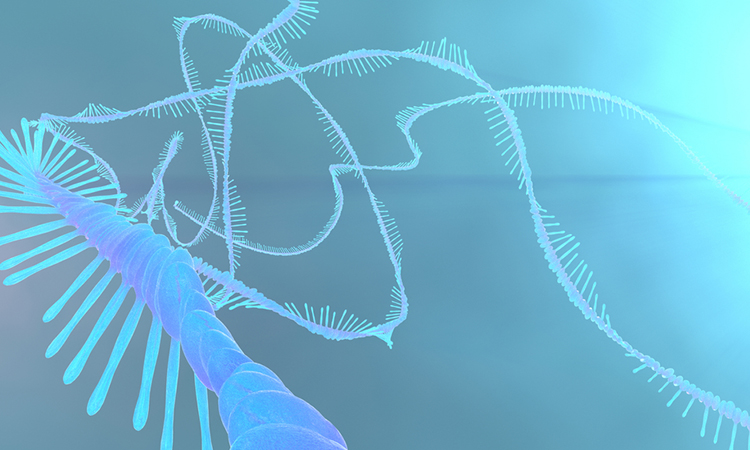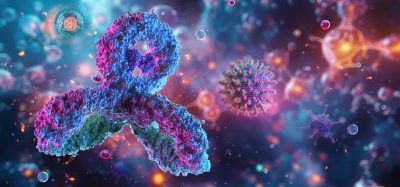The future of mRNA biology and AI convergence
Posted: 21 December 2023 | Taylor Mixides (Drug Target Review) | No comments yet
In the rapidly evolving landscape of mRNA biology and artificial intelligence (AI), Anima Biotech stands at the forefront, a unique approach that reshapes our understanding of diseases and transforms the drug discovery process. mRNA biology holds immense potential with RNAi drugs in the market and mRNA vaccines showing promise, particularly in cancer trials.

Where do you see the future of mRNA biology and AI converging, and how does Anima Biotech plan to lead this convergence?
mRNA biology has become widely recognised as a new “drug mine”. RNAi drugs are in the market and mRNA vaccines, initially developed for Covid-19, are already in trials for cancer. mRNA is an intermediate form that codes the instructions for making proteins but the biology around its regulation is not well understood and is still an “uncracked code”. Complex regulatory pathways move mRNAs through their life cycles and control when, where, and how much of each individual protein is made. Examples of such mechanisms include RBPs, splicing, and relocalisation of mRNAs among many others. All of these are novel targets to be explored in small molecule drug discovery as well as for improving the efficacy of mRNA vaccines.
However, our inability to understand that biology is what stands in the way of further progress. And really, this comes to the biggest question of all: what is the underlying mechanism of a given disease? There must be something different in those diseased cells, some dysregulated pathway that is causing that disease phenotype. And since mRNA biology is like the highway of cell biology, it would likely be visible there. And this is exactly where AI can provide us with an extremely powerful new strategy. The elucidation, or “decoding” of complex biology is becoming possible with AI’s ability to process large amounts of visual data and recognise patterns in images. We could use it to identify the underlying disease mechanism, the dysregulated pathway, or as we call it at Anima, the “disease signature”.
AI has become very capable in both understanding and generating images. So, you could capture images of live mRNA biology from millions of diseased and healthy cells and have an AI neural network trained to recognise the differences. It would see in the images the pathway that tells the diseased cells apart from the healthy ones, essentially elucidating the disease mechanism. You could then use large language models to research all available knowledge around that pathway and novel drug targets. This is where I see things going: using AI to process vast amounts of data coming through images taken from live biology of a disease model, identify what is causing the disease, the disease signature, and then have AI suggest targets along that pathway. You can then screen molecule libraries to find modulators of the underlying disease biology. So, as you can see, AI has the potential to completely transform the process by visualising and decoding disease biology.
Can you elaborate on how Anima’s unique approach to visualising the entire life cycle of mRNA in cells is revolutionising our understanding of diseases and potential treatments?
What we are doing at Anima is applying our proprietary mRNA biology visualisation technologies to generate millions of images of mRNA regulatory pathways in disease models. We feed them to our AI mRNA Image Neural Network which has been trained on over 2 billion such images, proprietary data that came from our projects across a decade. We pinpoint the disease mechanism and then apply our mRNA knowledge graph and our mRNA biology LLM, an augmented large language model that we built around mRNA knowledge. This elucidation of underlying disease biology is now happening at the beginning of a drug discovery process, rather than being tried at the end of it. For a very long time, companies had to choose between two very different approaches to drug discovery. The first approach is to come up with a proposed target and screen against that protein. The problem here is that you are betting on the target to have an effect on disease phenotype.
When drugs fail in the clinic it is mainly because we do not understand the disease mechanism. The target that was chosen is the “secret switch” to turn off the disease phenotype. So, this betting on a target is a real problem and for many diseases, we are still in the dark with regards to what is the real cause and do not understand the full biology. An alternative approach is phenotypic screening and there, you basically screen many molecules and look for those that reverse the phenotype. You don’t know the target and you are not betting on one. So, this approach has the advantage of being completely unbiased but its big downside is that you don’t have any prior understanding of the biology and even after you find some active molecules, it is still very hard to elucidate their mechanism of action and molecular targets.
Our mRNA Lightning platform represents a game changer that solves this fundamental problem. It retains the advantages of phenotypic screening, but it starts with an elucidation of disease biology. The process starts with an analysis of the disease in our mRNA knowledge graph, suggesting pathways that are most relevant to the disease. These become proposed disease mechanisms, pathways regulating mRNA biology. We then go into actual cells that are disease models. We take millions of images in a fully automated lab, and we give them as training data to our AI image neural network. It looks at the images of these proposed pathways and finds the one that shows the biggest change. That becomes the pathway that we will be targeting.
Notice that it will give you this pathway not from a couple of publications and a handful of experiments… It will look at the results of millions of single-cell experiments running in parallel and will recognise the common pattern. It will suggest a few alternatives by ranking possible pathways. Now we have a specific biological pathway to go after. We proceed with drug discovery by screening against actual disease mechanisms, the “disease signature”. We are looking for molecules that modify the image of the pathway in diseased cells, so they now look like the images coming from healthy cells. We are seeing that the exact pathway that we confirmed is the difference, so we have a preconceived notion of the MOA already. The molecules that are coming out of the screen as active compounds now can go through a rapid iterative process where biologists work with other major elements of the AI in our platform, namely the mRNA biology LLM and the Lightning copilot working together in our MOAi technology. It looks at the results and suggests confirmatory experiments to identify the molecular targets of compounds and this typically converges at a fraction of the time that it typically takes to identify the MOA of drugs. It is because we have identified the disease mechanism at the beginning of the process rather than attempting to elucidate it in the end.
From mRNA Lightning 1.0 to the current 3.0 version, Anima’s platform has seen significant evolution. What enabled these advancements, and what’s next on the horizon for Anima’s technology?
The technology that got us started was the ability to visualize the translation of mRNAs into proteins. This was “TranslationLight”, enabling for the first time to see in images where, when, and how much of the mRNA is translated. In version 1.0 we were leveraging this technology in order to identify molecules that modulate mRNA translation. We would basically look for compounds that affect the light. Molecules that were decreasing the light were inhibiting translation. If they increase the light, they increase translation. It was a very different readout that enabled us to run what seemed like a phenotypic screening but instead of being run “in the dark” it was running “in the light” because we were watching an actual major biological process, the translation of mRNAs. We are talking 2013 here so that was a decade ago. Since then, we have generated over a billion of such images from many disease models and cell types. We also built our first automated mRNA biology lab that was running those millions of experiments in cells and taking all these images, uploading them to the cloud for analysis. We built a lot of computational biology stuff to analyse them in order to identify active ones.
Our lead program in lung fibrosis emerged as a strong showcase of how all this worked. All this encouraged us to develop additional visualisation technologies and led to TranscriptLight, over a dozen visualisation technologies that enabled us to see mRNA transcripts, being it single or multiple. Now with this, we have expanded our capabilities to identify compounds that affect anything along the life cycle of mRNA, mRNA biology modulators. We would screen our libraries and see in images the effect of hit molecules on the mRNA, across its life cycle. By doing that we again expanded our image dataset, reaching nearly 2 billion images, the world’s largest dataset of mRNA biology visualisations. We also developed dozens of MOA assays that basically were the other side of these visualisations, experiments that would enable us to look at what a compound is doing and compare it to those known behaviours.
We expanded our automation in our “tera-scale” lab. Consider that all this was in 2020 and AI was still on the side lines as an experiment. But it became clear to us that we are generating a very large dataset of mRNA biology images, the only one in the world in fact and that has tremendous value. We started to consider how we could use AI to make sense of that data. In Lightning 2.0, we introduced MOAi, a technology that used AI to elucidate the mechanism of action of compounds. In Lightning 2.0, we introduced MOAi, a technology that used AI to elucidate the mechanism of action of compounds. The idea was that AI would take all evidence collected from the screen and advise biologists on the sequence of experiments to rapidly discover how compounds work. This was a big thing because we leveraged AI to tackle the biggest problem of phenotypic screening, to identify the MOA of hit compounds.
We would actually start doing that very early, right after the hit stage of the screening and it would run along the project by leveraging all the data. But it wasn’t until 18 months ago that the full power of AI could be brought into the platform in a way that is a game changer. And that came in Lightning 3.0 with the development of PathwayLight, the ability to visualise mRNA biology regulatory pathways. That was a turning point in the development of the platform. We could for the first time visualise disease mechanisms. We turned back to the dataset of the images we had, and we saw that for a given disease, we could train a neural network on images of diseased and healthy cells, use PathwayLight to see all different pathways, and identify the one that is dysregulated in the disease. The AI image network proved to be very effective in identifying these disease signatures. We then looked back at the vast amount of knowledge that we have collected over a decade around mRNA biology.
We decided to create the world’s first mRNA biology knowledge graph and apply LLM technology to interact with it. Earlier this year we incorporated into the platform the first generation of these technologies. So, with Lightning 3.0 what you are basically seeing is AI everywhere: there is AI on the imaging side, used to identify disease signatures, enabling us to screen against disease-relevant biological pathways. Then there is the mRNA knowledge graph and the LLM that is used to query that, and the Lightning co-pilot is a chat interface across the whole system that biologists can use to interact with all that data. It all comes together in Lightning 3.0 in the form of three applications: target discovery, drug discovery, and MOA discovery. Going forward we will continue to expand and integrate these three major applications.
How does the integration of AI, especially the LLM and the Lightning AI co-pilot, enhance the MOA discovery process, and what sets it apart from traditional methods?
Understanding the mechanism of action of drugs is a decades-long problem. There are many drugs for which the MOA has never been elucidated. Some companies have recently applied high-scale imaging and AI analysis technologies. They are looking for compounds that modify the image of diseased cells to look more like the healthy ones, but you are left with that problem. This seems much like what we have been talking about here but in fact, is different in a fundamental way. Cell morphology images do not provide any immediate biological meaning in the context of disease biology. What we are doing is very different. We are visualising the pathways in mRNA biology and not cell morphology. We identify the disease signature and find compounds that directly modulate that pathway. So, when we turn to the challenge of figuring out how these compounds are working, their MOAs, we already have a pretty good understanding and an inherent rationale for that. If they show that the image of the disease signature is modified from an image of diseased cells to healthy ones, and the mechanism of action and molecular targets must be around that pathway.
This fact is changing the game because now we have a pathway that we can study. You have a compound, and you have a hypothesis for the pathway it is working through. What you really need now is to figure out which experiments you must run to quickly understand which protein along the pathway could be the molecular target. You have a much smaller number of candidates, but it could still be hundreds of experiments in trial and error. They generate a lot of information and understanding all of these results and figuring out what to do next is still a big challenge. So, this is the 3rd place where AI is applied in the platform. MOAi takes the pathway and goes back to the knowledge graph. It then devises a strategy that is basically to decide on the sequence of experiments to conduct in order to move the MOA elucidation process forward. At each step, an experiment is conducted, and the results are brought back into the system. The information is brought back into the knowledge graph, expanding the original knowledge with actual results. This in turn makes the model look at all the data and suggest the next experiment. But doesn’t do this by itself or alone. We figured that LLMs are still highly experimental when it comes to their understanding of biology, so we created an architecture where MOAi is working through the Lightning co-pilot in a “biologist-in-the-loop” model. This means that biologists can ask the system for its suggestions for targets and experiments but can also suggest their own ideas and the system will evaluate them. The different MOAs are continuously ranked by considering the results from all experiments and you have like a compass visually gravitating to the north, which is the MOA. This is an iterative, creative process where biologists work with AI to elucidate the underlying mechanism of action but at the same time, it increases our understanding of the biology of the disease.
Given Anima’s partnerships with Lilly, Takeda, and AbbVie, and the 20 drug discovery programs in place, how do these validate Anima’s approach in mRNA biology?
Our partnerships with Lilly, Takeda, and AbbVie, coupled with our 20 active drug discovery programs indeed validate our technology and our overall approach in mRNA biology drug discovery. What these companies have recognised right away is that our unique ability to visualise mRNA biology gives them a whole new strategy in the discovery of drugs against many hard targets. You are actually seeing the disease mechanisms and how they play out to differentiate healthy and diseased cells. They then realised that we are also capable to analyse all that information and decode this mRNA biology. It is a fundamentally different approach from the ones that all the other players in small molecule mRNA drugs are taking. No one can visualise and decode mRNA biology. We are also the only company in the space that has built a platform that brings AI to mRNA biology.
Beyond drug discovery, how do you envision Anima’s technologies shaping the future landscape of mRNA biology research and applications in the coming years?
I like to call what we do “mRNA biology. AI” and I believe that this approach can significantly impact the entire landscape of mRNA biology research and applications. It provides major new insights into underlying disease biology. AI neural networks that recognise disease mechanisms and can identify the pathway that has become dysregulated, the “disease signature” is a huge step forward in our understanding of what is causing a given disease. This has the power to us discover treatments for so many diseases. This is the most important thing. Regarding applications, our platform really covers the whole process from target discovery, through drug discovery to MOA discovery, bringing the superpower of AI to transform the drug discovery process. There are companies out there using AI to analyse publications. That’s computational and it is valuable, but I believe that the ability to visualise actual mRNA biology in disease cells and to be able to decode that biology is key because you are now bringing all this experimental data from the real world and again you are using the power of AI LLM with a knowledge graph to make sense of all of that data.
We were talking mostly about small molecule drugs but really the approach and the platform are applicable across any research into mRNA biology. We are seeing now mRNA vaccine companies coming to us as they want to use these capabilities to better understand the biology around synthetic mRNAs and how they interact with the regulatory mechanisms. By understanding this they can improve the efficacy of those vaccines. So, it’s really all about that fundamental thing, bringing the superpower of AI to mRNA biology, visualising disease mechanism and really decoding that underlying biology. It is applicable to the discovery of novel targets and new drugs and to the understanding of how they work. We are just in the beginning of using AI across computational and experimental and there is tremendous potential here. I think that this is going to be transformational to our understanding of diseases and to the development of new treatments.
About the author
 Yochi Slonim
Yochi Slonim
Co-Founder & CEO, Anima Biotech
A serial entrepreneur in software and biotech, Yochi Slonim has built multiple companies as a founder and CEO through all phases of growth all the way to IPOs and large M&A exits. As a Co-founder and CEO of Anima Biotech, he is driving the company’s strategy and business development at the intersection of mRNA biology and AI.
Prior to Anima, Yochi was a co-founder of Mercury Interactive. As CTO and VP R&D from the company’s early days, he created product vision and strategy and led a multi-product organisation of 200 developers.
In 2000, Yochi was founder and CEO of Identify. Yochi founded ffwd.me, a unique startup acceleration program where he led a team that worked with over 25 startups in diverse areas and technologies, developing strategy, products and go to market operations while raising multiple rounds of financing from VCs and private investors.
Related topics
Artificial Intelligence, Drug Discovery, Drug Discovery Processes, Research & Development, RNAs, Targets
Related conditions
Cancer
Related organisations
Anima Biotech
Related people
Yochi Slonim (Anima Biotech)







